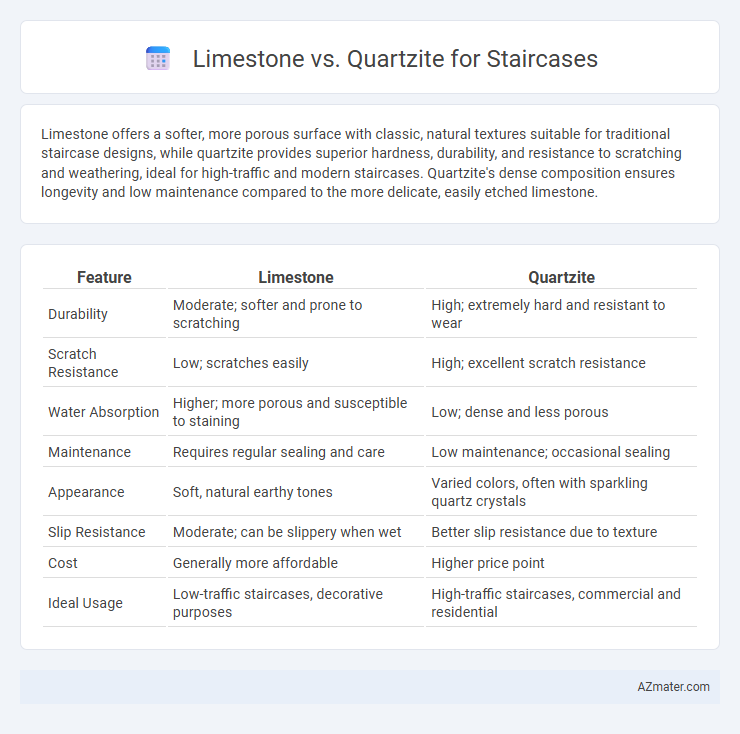Limestone offers a softer, more porous surface with classic, natural textures suitable for traditional staircase designs, while quartzite provides superior hardness, durability, and resistance to scratching and weathering, ideal for high-traffic and modern staircases. Quartzite's dense composition ensures longevity and low maintenance compared to the more delicate, easily etched limestone.
Table of Comparison
| Feature | Limestone | Quartzite |
|---|---|---|
| Durability | Moderate; softer and prone to scratching | High; extremely hard and resistant to wear |
| Scratch Resistance | Low; scratches easily | High; excellent scratch resistance |
| Water Absorption | Higher; more porous and susceptible to staining | Low; dense and less porous |
| Maintenance | Requires regular sealing and care | Low maintenance; occasional sealing |
| Appearance | Soft, natural earthy tones | Varied colors, often with sparkling quartz crystals |
| Slip Resistance | Moderate; can be slippery when wet | Better slip resistance due to texture |
| Cost | Generally more affordable | Higher price point |
| Ideal Usage | Low-traffic staircases, decorative purposes | High-traffic staircases, commercial and residential |
Introduction to Limestone and Quartzite Staircases
Limestone staircases offer a naturally soft texture and warm, earthy tones, making them ideal for classic and elegant interior designs. Quartzite staircases provide exceptional durability and resistance to scratching and etching, combined with a striking, glassy appearance that suits modern and high-traffic spaces. Both materials present unique aesthetic and functional qualities, influencing their selection based on design intent and maintenance requirements.
Key Differences Between Limestone and Quartzite
Limestone is a sedimentary rock composed mainly of calcium carbonate, offering a softer, more porous surface that requires regular sealing to prevent staining on staircases. Quartzite, a metamorphic rock formed from sandstone, features a much harder and denser structure with superior scratch and heat resistance, making it ideal for high-traffic staircases. The key differences include durability, maintenance needs, and appearance, with quartzite providing a glossy, glass-like finish and limestone showcasing a more matte, natural texture.
Durability: Limestone vs Quartzite
Quartzite offers superior durability compared to limestone for staircases due to its high hardness and resistance to abrasion, making it ideal for high-traffic areas. Limestone, being a softer sedimentary rock, is more prone to scratches, chips, and erosion over time, especially in moisture-prone environments. The dense crystalline structure of quartzite enhances its longevity and maintains its aesthetic appeal longer than the porous and softer limestone.
Aesthetic Appeal and Design Versatility
Limestone offers a warm, natural look with subtle textures and earthy tones that enhance classic and rustic staircase designs, while quartzite provides a striking, glossy finish with vibrant veining perfect for modern and contemporary aesthetics. Quartzite's hardness allows for intricate design versatility and durability, maintaining its polish and color over time, whereas limestone's softer composition lends itself to sculptural details and a weathered appearance that ages gracefully. Choosing between limestone and quartzite depends on the desired balance between timeless elegance and striking, high-performance beauty in staircase applications.
Slip Resistance and Safety Considerations
Limestone typically offers a softer, more porous surface that can become slippery when wet, posing potential safety risks on staircases. Quartzite provides superior slip resistance due to its natural hardness and textured finish, making it a safer option for high-traffic areas. Choosing quartzite enhances staircase safety by minimizing slip hazards while maintaining durability and aesthetic appeal.
Maintenance Requirements and Longevity
Limestone requires regular sealing to protect against stains and moisture, as it is a softer, porous natural stone that may wear or scratch over time, making maintenance more intensive. Quartzite is highly durable and resistant to scratches and stains, requiring minimal upkeep beyond routine cleaning, which contributes to its superior longevity for staircase applications. The inherent hardness of quartzite ensures it maintains its appearance and structural integrity longer than limestone under heavy foot traffic.
Cost Comparison: Limestone vs Quartzite
Limestone staircases typically cost less than quartzite due to the lower price of raw material and easier quarrying and processing methods. Quartzite, a harder and more durable natural stone, commands a higher price reflecting its superior resistance to wear and scratch, making it a longer-lasting choice for high-traffic areas. Budget-conscious renovations often favor limestone for its affordability, while quartzite justifies its premium cost through extended durability and lower maintenance expenses over time.
Installation Challenges and Tips
Limestone presents challenges during staircase installation due to its softness and porosity, requiring careful handling to prevent chipping and staining, while quartzite's hardness demands specialized cutting tools and precise labor to avoid cracking. Proper substrate preparation and secure anchoring systems are critical for both materials to ensure stability and durability in high-traffic areas. Applying sealants on limestone and using diamond blades for quartzite cutting can mitigate installation difficulties and enhance the longevity of staircase surfaces.
Environmental Impact and Sustainability
Limestone and quartzite differ significantly in environmental impact and sustainability for staircases, with limestone quarrying often causing more landscape disruption and higher carbon emissions compared to the harder quartzite, which requires less frequent replacement due to its durability. Quartzite's resistance to weathering and wear reduces maintenance frequency, enhancing its long-term sustainability credentials. Both materials can be sourced locally to minimize transportation emissions, but quartzite generally offers a lower overall environmental footprint due to its longevity and energy-efficient mining processes.
Choosing the Right Material for Your Staircase
Limestone offers a classic, warm aesthetic with moderate durability ideal for indoor staircases in low-traffic areas, while quartzite provides superior hardness and resistance to scratches and stains, making it perfect for high-traffic and outdoor staircases. When choosing the right material for your staircase, consider factors such as durability requirements, maintenance frequency, and the overall style of your home. Quartzite's natural quartz composition ensures longevity and minimal upkeep, whereas limestone requires sealing to prevent damage from moisture and wear.

Infographic: Limestone vs Quartzite for Staircase
 azmater.com
azmater.com